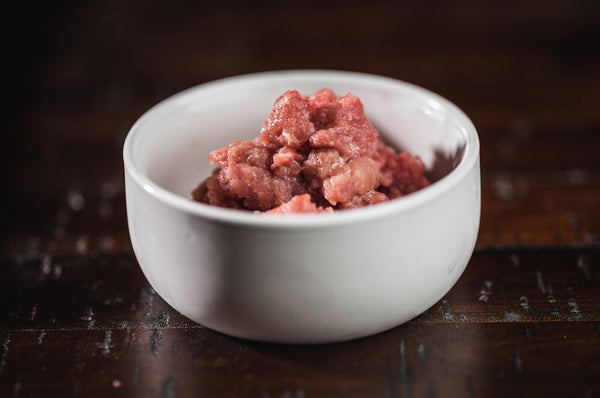Recommended Supplements for Pre-Made Grinds

The most common way of feeding a raw food diet is called “80/10/10”. This means that 80% of the bowl will consist of muscle meat, 10% bone, and 5% liver, and 5% other secreting organs. This method of feeding originated from trying to replicate whole prey in the wild. Where 80/10/10 usually falls short is that many times it does not include more of the obscure body parts such as eyeballs, brain, and fur/feathers. But unfortunately, with modern-day nutrition changing so drastically from canine’s ancestral diet, this means that feeding a diet just made of muscle meat, organs, and bone will not be sufficient!
Raw Feeding Miami’s premade grind is what I call “foundation” or “starter grinds” where they contain the main basis of a raw meal (muscle meat, organs, and bones) but it is vital to add in whole foods on top of them to fill in common nutrient gaps.
Common Nutrient Deficiencies
If a dog was only fed 80% muscle meat, 10% bone, and 10% organs with no extras then the animal would most likely be deficient in:
● Zinc● Magnesium
● Manganese
● Iodine
● Vitamin E
● Vitamin D
● Omega-3s

That’s a lot of essential nutrients that are lacking in the 80/10/10 diet! And long term deficiencies of these nutrients can have harmful side effects on the dog. Thankfully there are a vast amount of whole food sources to supply these vital nutrients to your pet!
Note: any serving suggestion is merely a guideline using the National Research Council (NRC) as a basis. To get custom-made meal plans please contact a professional & experienced canine nutritionist such as Perfect Rawsome or Raw Pets Rule.
It is important to note that excess of certain nutrients can have the same negative effects as a deficiency so blindly giving a food high in a certain vitamin or mineral is not how to safely "balance" a foundation grind.
Zinc
The National Research Council (NRC) suggests that a healthy adult dog should receive
15mg of zinc per 1000kcal.
When it comes to zinc, unfortunately, the food sources are quite limited. The highest whole food source of zinc are:

Canned Oysters - 25 mg per 1oz (28g)
Serving guideline:
-
Small dogs: .5 - 1 oyster
-
Medium dogs: 1 -2 oysters
-
Large dogs: 2 - 3 oysters
Magnesium
The richest source of magnesium are nuts/seeds, wheatgrass, leafy greens, and mackerel.

As long as you are adding a healthy variety and quantity of the foods mentioned above, will provide sufficient amounts of magnesium in the raw diet.
Manganese
The NRC suggests that the RA for manganese is 1.2mg per 1000Kcal for a healthy adult dog.
The foods highest in manganese are seeds & nuts, some leafy greens, and blue-lipped mussels.
My favorite whole foods to use for manganese are green tripe and blue-lipped mussels as they are the most biologically available source of manganese.
“What about fur & feathers?”

It's not so much a question of the presence of manganese but the bioavailability of the mineral. From what I have gathered, fur and feathers are very high in β-keratins. Keratin resists digestion for example, which is why cats cough up hairballs. Basically, fur and feathers are digestive enzyme proof and the nutrients in the fur &. feathers will not be broken down and absorbed. While fur and feathers cannot be broken down... wild carnivores must have been getting their manganese requirements somehow, right? As they were definitely not fishing, boiling, and eating blue mussels. But this just shows how much more we have to learn and explore and that mother nature has a beautiful and mysterious way of working. But as of now, foods best fed for manganese are blue-lipped mussels & tripe as we know how much manganese is in these foods.
Fur sources through RFM include: Dehydrated Rabbit Feet & Ears, Dehydrated Beef Ears, Dehydrated Lamb Ears, and/or Raw Beef Ears
Feeding guideline for blue-lipped mussels (most rich in mineral):
- Small dogs: 1-2 mussels
- Medium dogs: 3-4 mussels
- Large dogs: 5-6 mussels

Iodine
Foods high in iodine are unfortunately very limited. The main source being kelp and other seaweed and algae. My personal favorite brand of kelp is the NOW brand as it tells you exactly how much iodine there is per scoop. Plus it lasts forever since you only give around 1⁄2 the scoop.

For reference, here is how small the scoop is!
Note: Giving too much or too little iodine can have negative effects on the animal. When choosing an iodine supplement to feed it is vital to find one with an analysis of how much iodine is in the product. The small amounts of iodine detected in certain foods are usually not enough to meet NRC recommended amounts.
Serving guideline:
- Small dogs: 1⁄3 scoop
- Medium dogs: 1⁄2 scoop
- Large dogs: 1⁄2 scoop
Vitamin E
The RA for vitamin E is 7.5 mg per 1000Kcal for healthy adults & puppies.
Vitamin E, aka alpha-tocopherol, is a part of a group of eight fat-soluble compounds – four tocotrienols and four tocopherols, each identified with the prefixes alpha, beta, delta, and gamma.
Note: When purchasing a natural vitamin E supplement, you want to ensure it says “d-alpha tocopherol” not “dl-alpha-tocopherol”. The prefix “d-alpha” signifies the product is derived from a natural source while “dL-alpha” means it was extracted from a synthetic source

Foods richest in Vitamin E include seeds & nuts, and wheatgrass. The only con of using nuts and seeds is that it gets very calorie-dense very fast. Another great option is using a natural vitamin E supplement such as this one from NOW Foods.
Vitamin E drops serving guideline:
- Small dogs: .5 - 1 drops
- Medium dogs: 1 drop
- Large dogs: 2 drops
Vitamin D
The RA for vitamin D is 3.4mcg per 1000Kcal for adult dogs and puppies.
There are two types of vitamin D: Vitamin D3 (Cholecalciferol) & Vitamin D2 (Ergocalciferol)
Vitamin D3 is derived from animals and is, therefore, more bioavailable to canines. Whereas, D2 is found in plants so is less effective in dogs.
The highest sources of vitamin D are small oily fish as well as pasture-raised and finished animals.
As long as you are incorporating the foods above on a regular basis, it is sufficient enough to cover the needs of this vitamin.
Omega-3s
Omega-3s are not an essential vitamin & mineral but rather an essential fatty acid. The 3 main omega-3s being ALA, EPA, and DHA.
- Alpha-Linoleic Acid (ALA): Is a short-chain derived from plant-based sourced. ALA's conversion to EPA & DHA in the canine's body is questionable.
- Eicosapentaenoic acid (E PA): Long-chain derived from animal-based foods that is very bioavailable.
- Docosahexaenoic acid (DHA): Very similar to EPA with a slightly different shape and function, also very bioavailable.
- The RA for all the types of omega-3s per 1000Kcal are: ALA: 0.11g for adult dogs
- EPA/DHA: 0.11-2.8g for adult dogs
Foods richest in omega-3s consist of mainly shellfish, algae, and pasture-raised and finished animals.

Again, as long as you are incorporating the foods above on a regular basis, it is sufficient enough to cover the needs of this vitamin.

This list is the most common area that a ratio diet will be deficient in but depending on what you feed it could be more/less. Just remember that this diet is a guideline and not a rule! Even NRC guidelines are still just guidelines. Overall, the ratio diets are not ideal but they will not make your dog explode. But it is important to recognize where the 80/10/10 diet falls short and meets the needs of the dog's nutrients. We still know so little about nutrition and so much to learn. So, it's okay to make mistakes but it's vital that we learn from them.
The most important thing to remember is that every dog is a unique individual. This means that what works for one dog may or may not work for another. Try to avoid adding a new food or supplement just because someone else does. Everything in their bowl should have a purpose and be personalized to the dog. That's what makes a fresh food diet so awesome!
If you are a frequent feeder of Raw Feeding Miami grinds and want to ensure that you are supplementing appropriately, then the Perfectly Rawsome spreadsheet is for you! All feeding guidelines are created using Raw Feeding Miami’s 80/10/10 premade grinds as the diet’s foundation and include the addition of whole foods to create a three-day menu suitable for adult maintenance and puppy development life stages. Make sure to use “STORMY10” to save!
Content Written By: Hahnbee Choi


